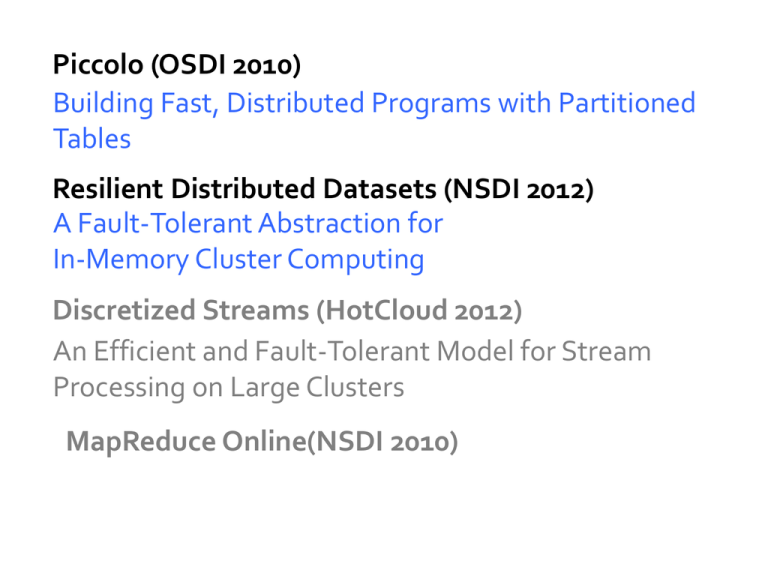Piccolo (OSDI 2010) Resilient Distributed Datasets (NSDI 2012) Tables
advertisement

Piccolo (OSDI 2010)
Building Fast, Distributed Programs with Partitioned
Tables
Resilient Distributed Datasets (NSDI 2012)
A Fault-Tolerant Abstraction for
In-Memory Cluster Computing
Discretized Streams (HotCloud 2012)
An Efficient and Fault-Tolerant Model for Stream
Processing on Large Clusters
MapReduce Online(NSDI 2010)
Motivation
MapReduce greatly simplified “big data” analysis
on large, unreliable clusters
But as soon as it got popular, users wanted more:
»More complex, multi-stage applications
(e.g. iterative machine learning & graph processing)
»More interactive ad-hoc queries
Response: specialized frameworks for some of
these apps (e.g. Pregel for graph processing)
Motivation
Complex apps and interactive queries both two
things that MapReduce lacks:
• Efficient primitives for data sharing
• A means for pipelining or continuous processing
MapReduce System
Model
•Designed for batch-oriented computations
over large data sets
– Each operator runs to completion before producing
any output
– Barriers between stages
– Only way to share data is by using stable storage
• Map output to local disk, reduce output to HDFS
Examples
HDFS
read
HDFS
write
HDFS
read
iter. 1
HDFS
write
. . .
iter. 2
Input
HDFS
read
Input
query 1
result 1
query 2
result 2
query 3
result 3
. . .
Slow due to replication and disk I/O,
but necessary for fault tolerance
Goal: In-Memory Data Sharing
iter. 1
iter. 2
. . .
Input
query 1
one-time
processing
Input
query 2
query 3
. . .
10-100× faster than network/disk, but how to get FT?
Challenge
How to design a distributed memory abstraction
that is both fault-tolerant and efficient?
Approach 1: Fine-grained
E.g., Piccolo (Others: RAMCloud; DSM)
Distributed Shared Table
Implemented as an in-memory (dist) key-value
store
Kernel Functions
Operate on in-memory state concurrently on
many machines
Sequential code that reads from and writes to
distributed table
Using the store
get(key)
put(key,value)
update(key,value)
flush()
get_iterator(partition)
User specified policies
… For partitioning
Helps programmers express data locality
preferences
Piccolo ensures all entries in a partition reside
on the same machine
E.g., user can locate kernel with partition,
and/or co-locate partitions of different related
tables
User-specified policies
… for resolving conflicts (multiple kernels
writing)
User defines an accumulation function (works if
results independent of update order)
… for checkpointing and restore
Piccolo stores global state snapshot; relies on
user to check-point kernel execution state
Fine-Grained: Challenge
Existing storage abstractions have interfaces
based on fine-grained updates to mutable state
Requires replicating data or logs across nodes
for fault tolerance
» Costly for data-intensive apps
» 10-100x slower than memory write
Coarse Grained: Resilient
Distributed Datasets (RDDs)
Restricted form of distributed shared memory
» Immutable, partitioned collections of records
» Can only be built through coarse-grained
deterministic transformations (map, filter, join, …)
Efficient fault recovery using lineage
» Log one operation to apply to many elements
» Recompute lost partitions on failure
» No cost if nothing fails
RDD Recovery
iter. 1
iter. 2
Input
query 1
one-time
processing
Input
query 2
query 3
. . .
. . .
Generality of RDDs
Despite their restrictions, RDDs can express
surprisingly many parallel algorithms
» These naturally apply the same operation to many items
Unify many current programming models
» Data flow models: MapReduce, Dryad, SQL, …
» Specialized models for iterative apps: BSP (Pregel),
iterative MapReduce (Haloop), bulk incremental, …
Support new apps that these models don’t
Tradeoff Space
Network
bandwidth
Fine
Granularity
of Updates
Memory
bandwidth
Best for
transactional
workloads
K-V
stores,
databases,
RAMCloud
Best for batch
workloads
HDFS
RDDs
Coarse
Low
Write Throughput
High
Spark Programming Interface
DryadLINQ-like API in the Scala language
Usable interactively from Scala interpreter
Provides:
» Resilient distributed datasets (RDDs)
» Operations on RDDs: transformations (build new RDDs),
actions (compute and output results)
» Control of each RDD’s partitioning (layout across nodes)
and persistence (storage in RAM, on disk, etc)
Spark Operations
Transformations
(define a new RDD)
Actions
(return a result to
driver program)
map
filter
sample
groupByKey
reduceByKey
sortByKey
flatMap
union
join
cogroup
cross
mapValues
collect
reduce
count
save
lookupKey
Task Scheduler
Dryad-like DAGs
Pipelines functions
within a stage
Locality & data
reuse aware
Partitioning-aware
to avoid shuffles
B:
A:
G:
Stage 1
C:
groupBy
D:
F:
map
E:
Stage 2
join
union
= cached data partition
Stage 3
Example: Log Mining
Load error messages from a log into memory, then
interactively search for various patterns
lines = spark.textFile(“hdfs://...”)
BaseTransformed
RDD
RDD
results
errors = lines.filter(_.startsWith(“ERROR”))
messages = errors.map(_.split(‘\t’)(2))
messages.persist()
tasks
Master
Msgs. 1
Worker
Block 1
Action
messages.filter(_.contains(“foo”)).count
Msgs. 2
messages.filter(_.contains(“bar”)).count
Worker
Msgs. 3
Result: scaled
full-text
tosearch
1 TB data
of Wikipedia
in 5-7 sec
in <1(vs
sec170
(vssec
20 for
secon-disk
for on-disk
data)data)
Worker
Block 3
Block 2
Fault Recovery
RDDs track the graph of transformations that
built them (their lineage) to rebuild lost data
E.g.:
messages = textFile(...).filter(_.contains(“error”))
.map(_.split(‘\t’)(2))
HadoopRDD
HadoopRDD
FilteredRDD
FilteredRDD
path = hdfs://…
func = _.contains(...)
MappedRDD
MappedRDD
func = _.split(…)
Iteratrion time (s)
Fault Recovery Results
140
120
100
80
60
40
20
0
Failure happens
119
81
1
57
56
58
58
57
59
57
59
2
3
4
5
6
Iteration
7
8
9
10
Example: PageRank
1. Start each page with a rank of 1
2. On each iteration, update each page’s rank to
Σi∈neighbors ranki / |neighborsi|
links = // RDD of (url, neighbors) pairs
ranks = // RDD of (url, rank) pairs
Example: PageRank
1. Start each page with a rank of 1
2. On each iteration, update each page’s rank to
Σi∈neighbors ranki / |neighborsi|
links = // RDD of (url, neighbors) pairs
ranks = // RDD of (url, rank) pairs
for (i <- 1 to ITERATIONS) {
ranks = links.join(ranks).flatMap {
(url, (links, rank)) =>
links.map(dest => (dest, rank/links.size))
}.reduceByKey(_ + _)
}
Optimizing Placement
Links
Ranks0
(url, neighbors)
(url, rank)
join
Contribs0
reduce
Ranks1
join
Contribs2
reduce
Ranks2
. . .
links
& ranks repeatedly joined
Can co-partition them (e.g. hash
both on URL) to avoid shuffles
Can also use app knowledge,
e.g., hash on DNS name
links = links.partitionBy(
new URLPartitioner())
Time per iteration (s)
PageRank Performance
200
171
Hadoop
150
100
50
0
Basic Spark
72
23
Spark + Controlled
Partitioning
Programming Models
Implemented on Spark
RDDs can express many existing parallel models
» MapReduce, DryadLINQ
» Pregel graph processing [200 LOC]
» Iterative MapReduce [200 LOC]
» SQL: Hive on Spark (Shark) [in progress]
All are based on
coarse-grained
operations
Enables apps to efficiently intermix these models
Spark: Summary
RDDs offer a simple and efficient programming
model for a broad range of applications
Leverage the coarse-grained nature of many
parallel algorithms for low-overhead recovery
Issues?
Discretized Streams
Putting in-memory frameworks to work…
Motivation
• Many important applications need to process
large data streams arriving in real time
– User activity statistics (e.g. Facebook’s Puma)
– Spam detection
– Traffic estimation
– Network intrusion detection
• Target: large-scale apps that must run on tenshundreds of nodes with O(1 sec) latency
Challenge
• To run at large scale, system has to be both:
– Fault-tolerant: recover quickly from failures and
stragglers
– Cost-efficient: do not require significant hardware
beyond that needed for basic processing
• Existing streaming systems don’t have both
properties
Traditional Streaming Systems
• “Record-at-a-time” processing model
– Each node has mutable state
– For each record, update state & send new records
mutable state
input records
node 1
push
node 3
input records
node 2
Traditional Streaming Systems
Fault tolerance via replication or upstream
backup:
input
input
node 1
node 3
input
node 2
node 1’
node 2
standby
node 3’
node 2’
node 3
input
synchronization
node 1
Traditional Streaming Systems
Fault tolerance via replication or upstream
backup:
input
input
node 1
node 3
input
node 2
node 3
input
synchronization
node 1’
node 1
node 2
standby
node 3’
Fastnode
recovery,
but 2x
2’
hardware cost
Only need 1 standby,
but slow to recover
Traditional Streaming Systems
Fault tolerance via replication or upstream
backup:
input
input
node 1
node 3
input
node 2
node 3
input
synchronization
node 1
node 2
node 1’
standby
node 3’
node 2’
Neither approach tolerates stragglers
Observation
• Batch processing models for clusters (e.g.
MapReduce) provide fault tolerance efficiently
– Divide job into deterministic tasks
– Rerun failed/slow tasks in parallel on other nodes
• Idea: run a streaming computation as a series
of very small, deterministic batches
– Same recovery schemes at much smaller timescale
– Work to make batch size as small as possible
Discretized Stream Processing
t = 1:
batch operation
input
pull
immutable dataset
(output or state);
stored in memory
without replication
immutable dataset
(stored reliably)
…
input
…
…
t = 2:
stream 1
stream 2
Parallel Recovery
• Checkpoint state datasets periodically
• If a node fails/straggles, recompute its dataset
partitions in parallel on other nodes
map
input dataset
output dataset
Faster recovery than upstream backup,
without the cost of replication
Programming Model
• A discretized stream (D-stream) is a sequence
of immutable, partitioned datasets
– Specifically, resilient distributed datasets (RDDs),
the storage abstraction in Spark
• Deterministic transformations operators produce
new streams
D-Streams Summary
• D-Streams forgo traditional streaming wisdom
by batching data in small timesteps
• Enable efficient, new parallel recovery scheme
MapReduce Online
…..pipelining in map-reduce
Stream Processing with HOP
• Run MR jobs continuously, and analyze data as
it arrives
• Map and reduce tasks run continuously
• Reduce function divides stream into windows
– “Every 30 seconds, compute the 1, 5, and 15
minute average network utilization; trigger an
alert if …”
– Window management done by user (reduce)
Dataflow in Hadoop
map
reduc
e
Local
FS
HTTP GET
map
Local
FS
reduc
e
Hadoop Online Prototype
• HOP supports pipelining within and between
MapReduce jobs: push rather than pull
– Preserve simple fault tolerance scheme
– Improved job completion time (better cluster utilization)
– Improved detection and handling of stragglers
• MapReduce programming model unchanged
– Clients supply same job parameters
• Hadoop client interface backward compatible
– No changes required to existing clients
• E.g., Pig, Hive, Sawzall, Jaql
– Extended to take a series of job
Pipelining Batch Size
• Initial design: pipeline eagerly (for each row)
– Prevents use of combiner
– Moves more sorting work to mapper
– Map function can block on network I/O
• Revised design: map writes into buffer
– Spill thread: sort & combine buffer, spill to disk
– Send thread: pipeline spill files => reducers
• Simple adaptive algorithm
Dataflow in HOP
Sched
ule
map
Pipeline
map request
Schedule +
Location
reduc
e
reduc
e
Online Aggregation
• Traditional MR: poor UI for data analysis
• Pipelining means that data is available at
consumers “early”
– Can be used to compute and refine an approximate
answer
– Often sufficient for interactive data analysis,
developing new MapReduce jobs, ...
• Within a single job: periodically invoke reduce
function at each reduce task on available data
• Between jobs: periodically send a “snapshot” to
consumer jobs
Intra-Job Online Aggregation
• Approximate answers published to HDFS by each
reduce task
• Based on job progress: e.g. 10%, 20%, …
• Challenge: providing statistically meaningful
approximations
– How close is an approximation to the final answer?
– How do you avoid biased samples?
• Challenge: reduce functions are opaque
– Ideally, computing 20% approximation should reuse
results of 10% approximation
– Either use combiners, or HOP does redundant work
Inter-Job Online Aggregation
reduc
e
Write Answer
map
HDFS
reduc
e
Job 1
Reducers
map
Job 2
Mappers
Inter-Job Online Aggregation
• Like intra-job OA, but approximate answers
are pipelined to map tasks of next job
– Requires co-scheduling a sequence of jobs
• Consumer job computes an approximation
– Can be used to feed an arbitrary chain of
consumer jobs with approximate answers
• Challenge: how to avoid redundant work
– Output of reduce for 10% progress vs. for 20%



